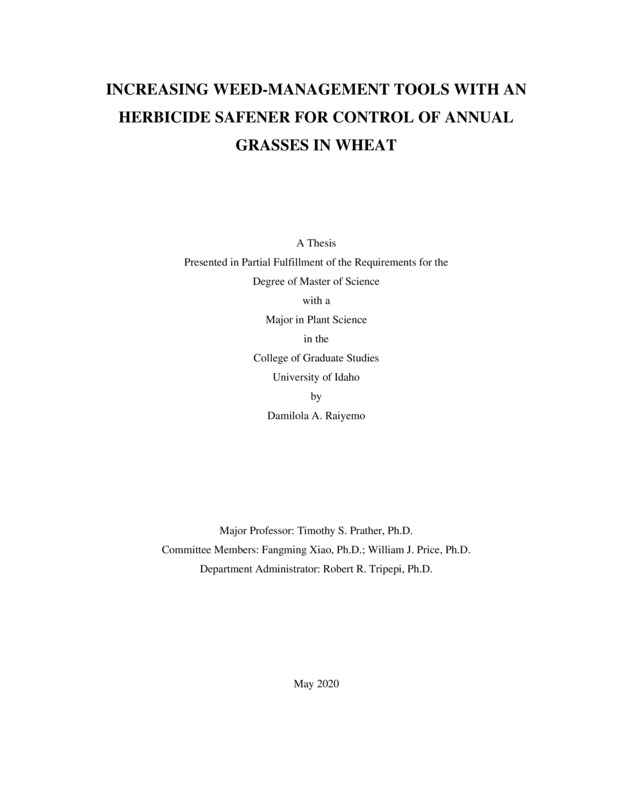INCREASING WEED-MANAGEMENT TOOLS WITH AN HERBICIDE SAFENER FOR CONTROL OF ANNUAL GRASSES IN WHEAT
Raiyemo, Damilola Alex. (2020-05). INCREASING WEED-MANAGEMENT TOOLS WITH AN HERBICIDE SAFENER FOR CONTROL OF ANNUAL GRASSES IN WHEAT. Theses and Dissertations Collection, University of Idaho Library Digital Collections. https://www.lib.uidaho.edu/digital/etd/items/raiyemo_idaho_0089n_11817.html
- Title:
- INCREASING WEED-MANAGEMENT TOOLS WITH AN HERBICIDE SAFENER FOR CONTROL OF ANNUAL GRASSES IN WHEAT
- Author:
- Raiyemo, Damilola Alex
- ORCID:
- 0000-0002-6521-2333
- Date:
- 2020-05
- Embargo Remove Date:
- 2021-08-26
- Keywords:
- Dose-response analysis Fluxofenim Pyroxasulfone Safener Soil-applied herbicides Wheat
- Program:
- Plant, Soil and Entomological Sciences
- Subject Category:
- Plant sciences
- Abstract:
-
The Pacific Northwest is a highly productive wheat growing region of the world. One of the challenges confronting wheat farmers in the region is control of weeds below levels that negatively impact crop yield. Annual grasses are most troublesome to wheat farmers in the region due to similarities in growth habits between wheat and annual grasses. Growers often rely on preemergence or early postemergence herbicides for control of annual grasses. Preemergence herbicides include the very-long-chain fatty acid synthesis (VLCFA) inhibitors, such as flufenacet, pyroxasulfone or their premix with other herbicides while early postemergence herbicides include (1) acetyl CoA carboxylase (ACCase) inhibitors, such as diclofop, pinoxaden, and (2) acetolactate synthase (ALS) inhibitors, such as flucarbazone, pyroxsulam, mesosulfuron. However, selection pressure from consistent herbicide use resulted in annual grasses evolving resistant populations to multiple groups of herbicides, leaving growers with few herbicide options for control.
The very-long-chain fatty acid-inhibiting herbicides are effective herbicides for control of annual grasses and small-seeded broadleaf weeds in corn, soybeans, wheat, cotton and sorghum with few reported cases of resistance. Pyroxasulfone, a VLCFA inhibitor, controls annual grass and small-seeded broadleaf weeds such as Italian ryegrass, barnyardgrass, foxtails, crabgrasses, Palmer amaranth and common waterhemp in corn, wheat and soybeans at low use rate with efficacy also against populations resistant to glyphosate, acetolactate synthase inhibitors, acetyl CoA carboxylase inhibitors and triazines. Despite the use of several VLCFA inhibitors for over six decades, potential problem associated with herbicides in the group is crop injury. Differential tolerance of crop varieties under adverse environmental conditions or soil type could hinder the selective use of some herbicides. Herbicide safeners, applied either as tank mixture with the herbicide for preemergence or postemergence use or as seed treatments in the form of seed dressing have been used to protect crops from herbicide injury. Safeners increase the expression of genes encoding enzymes involved in herbicide detoxification including cytochrome P450 monooxygenases, glycosyltransferases, glutathione S-transferases and ATP-binding cassette transporters. Fluxofenim (Concep III, Syngenta Crop Protection, LLC, Greensboro, NC) is a widely used seed treatment safener for protection of sorghum from S-metolachlor injury at the rate of 0.4 g ai kg-1 seed. Perhaps, fluxofenim could protect newly bred wheat cultivars of the Pacific Northwest from soil-applied preemergence herbicides.
Chapter 1 includes a general introduction to wheat production in Idaho, challenges of annual grass control in wheat, herbicide options for annual grass control in wheat, effectiveness of very-long-chain fatty acid-inhibiting herbicides in annual grass control, tolerance of crops to VLCFA inhibitors via rapid metabolism, concept of crop safening, history, mechanism of action and use. Chapter 2 provides information on series of experiments evaluating the protection of soft white wheat varieties and a hard spring wheat variety from very-long-chain fatty acid-inhibiting herbicides using fluxofenim safener. Data analysis showed that fluxofenim protection of soft white wheat varieties from VLCFA-inhibiting herbicides was variety-dependent. Fluxofenim significantly increased dry biomass of varieties LWW 15-72223, LWW 14-75044, Bruneau and UI Sparrow for S-metolachlor and dimethenamid-P herbicides, and LWW 15-72458 for pyroxasulfone herbicide. Varieties 09-15702A, UI Castle CL+ and UI Palouse CL+ were however tolerant to the three herbicide treatments regardless of fluxofenim treatment at the herbicide rates evaluated. Dose-response analysis showed effective doses resulting in 10% biomass reduction due to fluxofenim-alone treatment ranged from 0.55 g ai kg-1 seed for UI Magic CL+ to 1.23 g ai kg-1 seed for UI Palouse CL+. Effective doses resulting in 90% tolerance to S-metolachlor due to fluxofenim ranged from 0.07 g ai kg-1 seed for UI Castle CL+ to 0.55 g ai kg-1 seed for Brundage 96 and a similar pattern of response to dimethenamid-P and pyroxasulfone herbicides were also observed for the varieties, suggesting UI Castle CL+ has some level of tolerance to the herbicides. Glutathione S-transferase (GST) assay revealed that variety UI Castle CL+ had a 58% increase in GST specific activity relative to UI Sparrow and Brundage 96 with 30% and 38% increase in enzyme activity respectively at 0.36 g ai kg-1 seed treatment. Chapter 3 describes experiments to determine fluxofenim protection of six soft white winter wheat varieties selected based on prior greenhouse experiments from S-metolachlor, dimethenamid-P or pyroxasulfone injury under field conditions. Wheat density, height, head count and grain yield were evaluated in response to herbicide treatments with or without fluxofenim safener. Results indicated that fluxofenim had a negative impact on parameters observed in these field studies. Fluxofenim at 0.4 g ai kg-1 seed sorghum label rate failed to confer protection to soft white wheat varieties in the field studies conducted in fall 2018. The results of these field studies were therefore inconclusive and efficacy of fluxofenim to protect winter wheat would need to be evaluated further under different environmental conditions and soil types.
- Description:
- masters, M.S., Plant, Soil and Entomological Sciences -- University of Idaho - College of Graduate Studies, 2020-05
- Major Professor:
- Prather, Timothy S
- Committee:
- Xiao, Fangming; Price, William J
- Defense Date:
- 2020-05
- Identifier:
- Raiyemo_idaho_0089N_11817
- Type:
- Text
- Format Original:
- Format:
- application/pdf
- Rights:
- In Copyright - Educational Use Permitted. For more information, please contact University of Idaho Library Special Collections and Archives Department at libspec@uidaho.edu.
- Standardized Rights:
- http://rightsstatements.org/vocab/InC-EDU/1.0/

